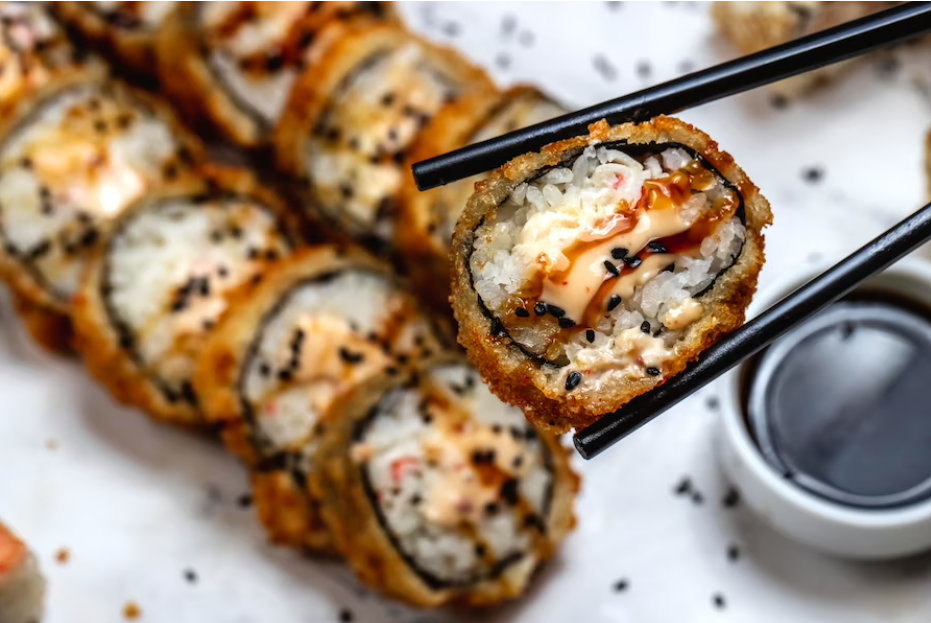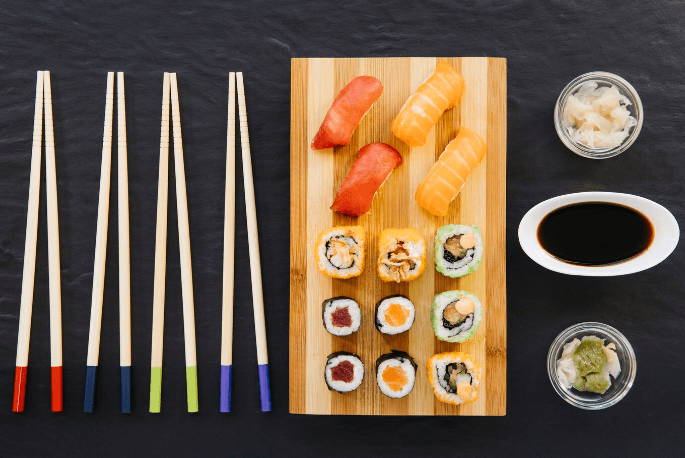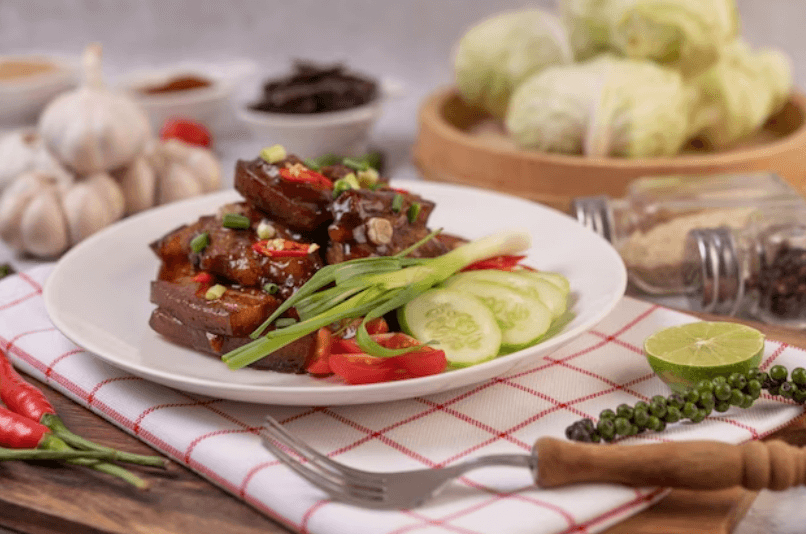Best Yellowtail Sushi Roll Recipes

Are you a sushi lover looking for new and exciting recipes to try at home? Look no further than the delicious and versatile yellowtail sushi roll! This delectable dish features fresh, buttery yellowtail fish wrapped in seaweed and rice, creating a satisfying balance of flavors and textures. Whether you’re a seasoned pro or just starting out with homemade sushi, this guide will provide everything you need to know about making the best yellowtail sushi rolls right in your own kitchen. So get ready to impress your friends and family with these mouth-watering creations!
What is Yellowtail?
Yellowtail is a type of fish commonly found in the Pacific Ocean, particularly around Japan and Hawaii. It’s also known as Hamachi, which means “”amberjack”” in Japanese. The name yellowtail refers to its bright yellow tail fin.
The flesh of Yellowtail is firm with a delicate texture and has a mild sweetness that makes it an excellent choice for sushi rolls. It’s rich in omega-3 fatty acids which are essential for heart health and brain function.
Yellowtail can be eaten both raw or cooked, but it’s most popular when served raw as sashimi or sushi rolls due to its buttery flavor and smooth texture. When cooked, Yellowtail tastes similar to other white fish like cod or halibut.
It’s important to note that not all types of Amberjack are suitable for making Yellowtail sushi rolls. Only the high-quality ones from sustainable sources should be used for your recipes. Always check with your local fishmonger before purchasing any type of fish you plan on using for your dishes!
Taste and Texture of Yellowtail
Yellowtail is a type of fish that has a mild, buttery flavor with a slightly sweet undertone. Its texture is firm yet delicate, making it perfect for sushi dishes.
When you bite into yellowtail sushi, you’ll notice the tender flesh of the fish melting in your mouth, leaving behind its rich and savory flavors. The taste of yellowtail blends well with other ingredients such as avocado or scallions to create unique sushi rolls with contrasting tastes and textures.
The texture of yellowtail can vary depending on how it’s prepared. When served raw in sashimi form, yellowtail has a smooth and silky texture that pairs perfectly with soy sauce or wasabi. However, when cooked or seared lightly, the texture becomes firmer while still retaining its delicate flavor.
One appealing aspect of yellowtail is that it isn’t too overpowering; instead, it complements other ingredients so well. Yellowtails are high in fat content which gives them their signature buttery flavor but also makes them more satisfying than some leaner options.
The taste and texture profile make Yellowtail an excellent choice for those who prefer milder-tasting seafood without sacrificing quality or richness.
The Role of Yellowtail in Sushi
Yellowtail, also known as Hamachi in Japanese, is a popular fish used in the making of sushi. Its mild flavor and buttery texture make it an excellent choice for sushi enthusiasts who prefer delicate flavors.
In sushi, yellowtail plays a significant role as one of the most beloved ingredients. It provides a rich and savory taste that complements other sushi components such as rice, nori sheets, and vegetables.
Apart from its delicious flavor profile, yellowtail is also highly nutritious. It’s an excellent source of protein and omega-3 fatty acids which are essential nutrients for maintaining overall good health.
When added to sushi rolls or nigiri pieces, yellowtail adds depth to the dish while still retaining its natural taste. The fish can be served raw or cooked depending on personal preference.
Additionally, Yellowtail’s versatility makes it suitable for various types of sushi dishes ranging from traditional rolls to modern fusion creations like spicy tuna rolls with yellowtail toppings.
The role of Yellowtail in Sushi cannot be overstated – it’s an integral part of many classic recipes that continue to delight both newbies and seasoned foodies alike!
The Tradition of Yellowtail in Sushi
The tradition of using yellowtail in sushi dates back centuries. In Japan, it is known as Hamachi and has been a staple ingredient in the cuisine for generations. Yellowtail was often used as an offering to the gods during religious ceremonies due to its high quality and taste.
In traditional sushi, yellowtail is one of the most respected fish and is considered a delicacy. It is typically served raw with little seasoning or garnish so that the natural flavor can be appreciated. The gentle sweetness combined with a rich buttery texture makes it highly sought after by sushi connoisseurs.
Many chefs still follow traditional methods when preparing yellowtail sushi such as using only fresh ingredients sourced locally or from specific regions known for their high-quality seafood. They also carefully select parts of the fish that are suitable for use in sushi rolls to ensure consistency and quality.
Yellowtail continues to hold a significant place in Japanese culture today, not just for its culinary value but also for its spiritual significance. By incorporating this ingredient into your homemade sushi recipes, you can experience a small part of this rich cultural heritage while enjoying delicious flavors at home.
Essential Ingredients for Yellowtail Sushi
When it comes to making delicious yellowtail sushi, the quality of the ingredients is key. Here are some essential ingredients you’ll need:
1. Yellowtail: Of course, the star ingredient in any yellowtail sushi roll is fresh and high-quality yellowtail fish.
2. Sushi Rice: The rice used in sushi plays a crucial role in determining its texture and taste. It should be short-grain, sticky rice that has been properly cooked with vinegar, sugar, and salt.
3. Nori: This seaweed wrapper provides additional flavor and texture to your rolls while also holding everything together.
4. Vegetables: You can add various types of vegetables like cucumber, carrot or avocado for extra crunchiness and flavour.
5. Sauce & Spices: Soy sauce (or Tamari sauce if gluten-free), wasabi paste (for those who like a bit of heat), pickled ginger (to cleanse your palate between bites) are traditional sauces for dipping.
6. Other Accessories – A bamboo mat will help you create tight rolls without tearing the nori sheet apart; plastic wrap prevents sticking on mat during preparation; sharp knives slice into uniform pieces cleanly without damaging their shape
Be sure to source each ingredient from reliable sources so that they are as fresh as possible!
Sourcing High-Quality Yellowtail
Sourcing high-quality yellowtail is crucial when it comes to making delicious sushi rolls. Here are some tips for finding the best yellowtail for your recipe.
Firstly, look for a reputable fishmonger or seafood supplier in your area. They should be able to provide you with fresh and sustainably sourced yellowtail.
When selecting fresh yellowtail, make sure that the flesh is firm and has a bright appearance. The eyes of the fish should also be clear and bulging, indicating that it’s been recently caught.
Frozen yellowtail can also be a great option if you’re unable to find fresh ones. However, ensure that they’re properly frozen at sea or immediately after being caught to preserve their freshness.
Another option is purchasing pre-packaged yellowtail fillets from Japanese grocery stores or online suppliers specializing in Japanese cuisine. These often come with detailed information about where and how the fish was sourced and processed.
Remember that sourcing high-quality ingredients will always yield better results in terms of taste and texture when making sushi rolls with yellowtail as one of its main components.
Basic Yellowtail Sushi Roll Recipe
The basic yellowtail sushi roll recipe is the perfect starting point for those new to making sushi at home. To begin, you will need a few essential ingredients such as high-quality yellowtail fillets, sushi rice, nori sheets, wasabi paste and soy sauce.
Before getting started with the rolling process, it’s important to cook the sushi rice according to instructions and let it cool. Once your rice has cooled down to room temperature, spread a thin layer of it onto your nori sheet using wet fingers.
Next up is adding in your fillings – thinly sliced pieces of raw yellowtail work especially well here. You can also add additional ingredients like avocado or cucumber if desired.
Once you have all of your fillings arranged on top of the rice-covered nori sheet, carefully start rolling from one end until you reach the other side. Using a sharp knife dipped in water between each cut, slice into bite-sized pieces.
Serve alongside some pickled ginger and soy sauce for dipping! This simple yet delicious recipe is sure to impress any dinner guests and leave them wanting more.
Variations of Yellowtail Sushi Roll Recipes
Yellowtail sushi rolls are incredibly versatile and can be customized to suit your taste preferences. Here are some variations that you can try:
1. Yellowtail and Scallion Roll: This is a simple yet delicious roll that highlights the delicate flavor of yellowtail. Simply combine slices of fresh yellowtail with chopped scallions, rice vinegar, soy sauce, and sesame oil.
2. Spicy Yellowtail Roll: For those who like it hot, add some heat to your yellowtail sushi by adding spicy mayo or sriracha sauce to the filling mixture.
3. Yellowtail Avocado Roll: Add some creaminess to your yellowtail sushi by combining avocado slices with the fish in the roll.
4. Rainbow Roll: Add various types of fish on top of your traditional yellow tail roll including tuna, salmon, crab stick and avocado for a colorful twist on this classic dish.
Experimenting with different ingredients and flavors is part of what makes sushi so fun! Don’t be afraid to get creative and come up with your own unique spin on these recipes.
Yellowtail and Scallion Roll
One of the most popular yellowtail sushi roll variations is the yellowtail and scallion roll. This recipe brings together the buttery taste of yellowtail with the sharp bite of fresh scallions, creating a delicious blend of flavors.
To make this sushi roll at home, you will need high-quality yellowtail fillets, nori sheets, cooked sushi rice, soy sauce, wasabi paste and thinly sliced scallions.
Begin by spreading a layer of sushi rice over your nori sheet and placing thin slices of yellowtail on top. Add a line of sliced scallions down the center before rolling up tightly.
Once rolled up into a cylindrical shape, slice your yellowtail and scallion rolls into even pieces using a sharp knife. Serve with soy sauce and wasabi paste for dipping.
This variation is perfect for those who enjoy bold flavors in their sushi rolls. The combination of sweet yellowtail with spicy notes from the fresh green onions creates an exciting contrast that keeps diners coming back for more.
Spicy Yellowtail Roll
Spicy Yellowtail Roll is a delicious sushi roll that combines the delicate sweetness of yellowtail with a fiery kick. This roll is perfect for those who love their sushi with a bit of heat. The spice in this roll comes from adding spicy mayo, sriracha sauce or chili oil to the filling.
To make Spicy Yellowtail Roll, start by preparing your sushi rice and cutting your yellowtail into thin slices. Then spread the rice onto your nori sheet and add some sliced avocado, cucumber, and green onion to one end of the rice.
Next, add your thin slices of yellowtail on top of the veggies. Drizzle some spicy mayo or other hot sauce on top before carefully rolling up your sushi.
The result is a flavorful explosion in every bite! You get the buttery texture and mild flavor of yellowtail combined with crunchy vegetables and a punchy spiciness that leaves you wanting more.
Spicy Yellowtail Roll adds an exciting twist to traditional sushi rolls – it’s rich in taste yet not too heavy. It’s also fairly easy to prepare at home once you have all the ingredients ready!
Yellowtail Avocado Roll
The Yellowtail Avocado Roll is a delicious sushi roll that combines the rich, buttery flavor of yellowtail with the creamy texture of avocado. To make this roll, you will need high-quality yellowtail and ripe avocados.
To start, lay out your nori sheet on a bamboo mat and spread cooked sushi rice evenly over it. Next, place thin slices of yellowtail on top of the rice and add sliced avocado alongside it. Gently roll up the mat to form a tight cylinder.
Once rolled up, slice into bite-sized pieces and serve with soy sauce or ponzu sauce for dipping. The combination of flavors in this roll makes it a popular choice among sushi lovers.
For added texture and crunch, some variations also include adding cucumber or tempura flakes to the filling mixture before rolling. However you choose to customize your Yellowtail Avocado Roll recipe, be sure to use only fresh ingredients for optimal taste.
Expert Tips for Making Yellowtail Sushi at Home
Making sushi can seem intimidating, but with a little practice and the right ingredients, it’s not as difficult as you might think. Here are some expert tips to help you make delicious yellowtail sushi at home.
1. Start with fresh ingredients
The key to making great sushi is using high-quality, fresh ingredients. Make sure your yellowtail is of the best quality possible and that all other ingredients are fresh and well-prepared.
2. Use the right rice
Sushi rice should be short-grain and sticky so that it holds together well when rolled into a roll or nigiri shape. Use Japanese short-grain rice specifically labeled “”sushi rice”” for best results.
3. Have patience when rolling
When rolling your yellowtail sushi rolls, take your time! It can be tempting to rush through this step, but taking extra care will ensure that your rolls hold together properly.
4. Invest in good tools
Having the right tools on hand can make all the difference when making sushi at home. Consider investing in a bamboo mat or professional-grade knives made specifically for cutting fish and other delicate ingredients.
5. Experiment with flavors
Don’t be afraid to get creative! Try adding spicy mayo or incorporating different vegetables like cucumber or carrot into your yellowtail roll recipes for added flavor and texture.
By following these expert tips, you’ll be able to create delicious yellowtail sushi from scratch in no time!
Handling and Storing Yellowtail
Proper handling and storage of yellowtail is crucial to maintain its freshness and flavor. When purchasing yellowtail, make sure it is shiny, has clear eyes, firm flesh, and a fresh scent. Once you bring the fish home, store it in the coldest part of your fridge or on ice if possible.
If you plan to use it within two days, keep it in its original packaging or wrap tightly with plastic wrap. If not using immediately, remove any excess moisture by patting dry with paper towels before wrapping tightly with plastic and storing in a resealable bag or airtight container.
When thawing frozen yellowtail for sushi making purposes, do so slowly in the refrigerator overnight rather than at room temperature which can cause bacterial growth. Never refreeze previously frozen yellowtail as this will compromise its quality.
Following these simple tips will help ensure that your yellowtail stays fresh and delicious for all your sushi-making needs.
Nutritional Value of Yellowtail Sushi
Yellowtail sushi is a nutritious and delicious meal that offers many health benefits. Yellowtail, also known as Hamachi, is an excellent source of high-quality protein and contains essential amino acids that our bodies need to function correctly.
In addition to its protein content, yellowtail is rich in omega-3 fatty acids, which are vital for heart health. These healthy fats can help lower cholesterol levels and reduce the risk of heart disease.
Yellowtail sushi rolls are also low in calories compared to other types of sushi rolls. They contain no added sugars or unhealthy fats, making them an ideal choice for those watching their weight or trying to maintain a healthy diet.
Furthermore, yellowtail sushi includes various vegetables such as avocado and cucumber that add fiber and nutrients like potassium into your diet. The seaweed wrap called nori used in sushi rolls may aid digestion due to it containing dietary fiber – promoting bowel movement regularity.
Incorporating yellowtail sushi into your diet can provide many nutritional benefits without sacrificing taste!
Pairing Yellowtail Sushi with Sides and Drinks
Yellowtail sushi rolls are a delicacy that can be enjoyed as a standalone meal or paired with other foods and drinks. To enhance the flavor of your yellowtail sushi, consider pairing it with complementary sides and beverages.
When it comes to sides, edamame beans are an excellent choice for their salty taste and crunchy texture that complements the smoothness of yellowtail. Additionally, miso soup is always a great option as its savory broth provides balance to the flavors in your mouth.
For drinks, you have many options available depending on your mood. Green tea is an authentic Japanese beverage that pairs well with any type of sushi due to its clean taste and antioxidant properties. For those looking for something stronger, sake or Japanese beer will do just fine.
Don’t forget about condiments! Soy sauce adds saltiness while wasabi brings heat to the table – use sparingly!
In summary, pairing yellowtail sushi with side dishes such as edamame beans or miso soup while sipping on green tea or sake creates a harmonious dining experience for all senses involved.
Serving Yellowtail Sushi
Serving Yellowtail Sushi is a crucial step in ensuring that your guests enjoy the full experience of this delectable dish. The presentation should be impeccable, and there are several ways to achieve this.
One way to serve Yellowtail Sushi is on a traditional sushi platter with pickled ginger, wasabi, and soy sauce. Arrange the rolls neatly on the plate and garnish with sesame seeds or thinly sliced scallions for an added touch of color.
Alternatively, you can get creative with your presentation by using unique serving dishes such as bamboo boats or individual spoons. This adds an element of surprise and intrigue to your table setting while still allowing guests to indulge in the flavors of the Yellowtail Sushi roll.
When it comes to drinks, sake pairs exceptionally well with sushi due to its light flavor profile that won’t overpower the delicate fish taste. Alternatively, try pairing your Yellowtail Sushi with green tea for a refreshing and healthful drink option.
Serving Yellowtail Sushi requires attention to detail in both presentation and accompaniments. By putting effort into these aspects of the meal, you will elevate your guests’ dining experience considerably.
Frequently Asked Questions:
Q: Can I make yellowtail sushi with cooked fish?
A: While it is possible to use cooked yellowtail for sushi, it may not result in the same texture and flavor as using raw fish. If you do choose to use cooked fish, be sure to cook it properly and handle it safely.
Q: What sides and drinks pair well with yellowtail sushi?
A: Traditional Japanese accompaniments like miso soup, edamame beans, and pickled vegetables can complement the flavors of yellowtail sushi. As for beverages, green tea or sake are popular choices.
Q: How do I source high-quality yellowtail?
A: Look for a reputable seafood market that sources their fish from sustainable fisheries. Ask questions about how the fish was caught and handled, and look for visual cues like bright eyes and firm flesh.
Q: What’s the best way to store leftover yellowtail sushi?
A: Leftover sushi should be stored in an airtight container in the refrigerator as soon as possible after eating. It’s best consumed within 24 hours of being made.
Q: Is making homemade sushi difficult?
A: Sushi-making can take some practice but can also be a fun activity to do at home! Start with simple recipes like basic rolls before moving on to more advanced techniques like nigiri or sashimi. Be sure to have all necessary equipment on hand such as bamboo mats and sharp knives.
Can You Make Yellowtail Sushi with Cooked Fish?
Yellowtail sushi is traditionally made with raw yellowtail fish, but many people wonder if it’s possible to use cooked fish instead. While some may prefer the taste and texture of raw yellowtail in their sushi, it is possible to make a delicious yellowtail roll using cooked fish.
If you choose to use cooked yellowtail for your sushi, be sure to cook it gently so that the meat remains moist and tender. You can grill or poach the fish before slicing it thinly for your rolls.
Another option is to use leftover fried or baked yellowtail as a filling for your sushi. This method adds a crunchy texture and unique flavor profile to your rolls.
It’s important to note that when using cooked fish in sushi, you should always refrigerate any leftovers promptly and discard them after one day. Raw fish has more natural preservatives than cooked seafood, making it safer for consumption over time.
In summary, while traditional yellowtail sushi calls for raw fish, there are ways to incorporate cooked yellowtail into your rolls. Just remember to handle it safely and enjoy experimenting with different flavors!
Conclusion
Yellowtail sushi roll is an incredibly delicious and healthy dish that has been enjoyed by many sushi lovers around the world. The flavor, texture, and freshness of yellowtail make it a perfect ingredient for sushi rolls.
In this article, we have explored the basics of yellowtail sushi rolls, including what yellowtail is, its taste and texture, essential ingredients needed to prepare a basic recipe along with expert tips on how to make them at home. We also discussed different variations like Yellowtail Scallion Roll or Spicy Yellowtail Roll as well as nutritional values.
With all these information available in your hands now you can easily try out some amazing yellowtail sushi roll recipes right from your kitchen without any hassle. So don’t wait any longer – head over to your local fish market or grocery store today and pick up some high-quality yellowtail so that you too can enjoy this delicious delicacy!





